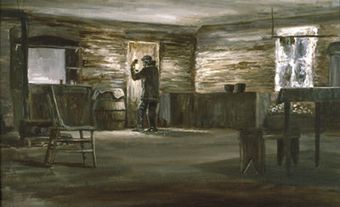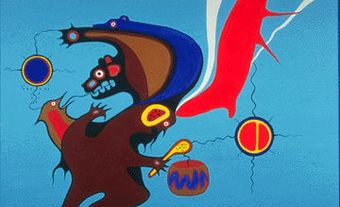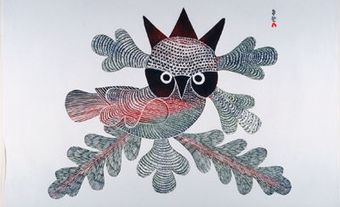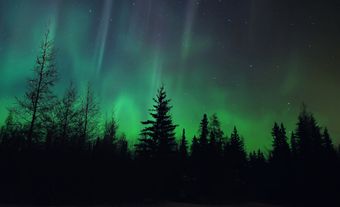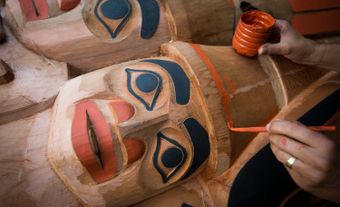Carl Ray, Cree artist, illustrator, editor and art teacher (born January 1943 in Sandy Lake, ON; died 26 September 1978 in Sioux Lookout, ON). Ray was known for his innovative paintings in the Woodlands style and was a founding member of the Indian Group of Seven. Ray’s work has influenced Indigenous art in Canada and can be found in the collections of various galleries and museums across the country.
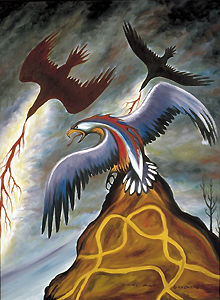
Early Life
Carl Ray was born on Sandy Lake First Nation in northern Ontario in 1943. After leaving a residential school in McIntosh at age 15 when his father died, Ray worked as a trapper, logger and goldminer to make his living. He began to paint during this time; he has been described as a self-taught painter.
Ray left Sandy Lake to work at the Red Lake mines. He contracted tuberculosis, eventually recovering in the Fort William sanatorium. He used painting as a form of occupational therapy. Ray returned to Sandy Lake in 1966.
Artistic Style
In his early career, Carl Ray became friend and apprentice to Ojibwe artist Norval Morrisseau, often credited as the creator of the Woodlands School of art. Not to be confused with a physical school, Woodlands is a style of art. It depicts traditional Indigenous legends as well as the relationships between people, animals and the supernatural. It is for these reasons that Woodlands art is also sometimes called Legend Painting or Medicine Painting. Though Woodlands artists do not paint in a uniform style, they are known for creating pieces characterized by bright colours and black form lines. They also have a unique X-ray style of painting, often showing the organs and internal energy lines of an animal or mythical figure.
Ray became known as a Woodlands artist because of his painting style. He was one of the first Cree painters in Canada to reject traditional bans against depicting sacred Indigenous legends. He frequently painted dynamic relations between humans, animals and legendary creatures. Ray usually limited his palette to two or three colours, such as brown, black and blue, often using both ink and watercolours. Ray also incorporated the X-ray style and painted his interpretations of stories that he had learned from his grandfather, a revered Ojibwe medicine man from Sandy Lake. (See also Shaman.)
Did You Know?
Artists of the Woodlands School came to be known by that name because they largely came from northern Ontario communities. In addition to Norval Morrisseau and Carl Ray, Woodlands artists include Daphne Odjig (1919–2016), Joshim Kakegamic (1952–1993), Blake Debassige (b. 1956) and Jackson Beardy (1944–1984).
Indian Group of Seven
In 1972, three Woodlands school artists —Jackson Beardy, Alex Janvier and Daphne Odjig— were part of a ground-breaking exhibition entitled Treaty Numbers 23, 287, 1171 that was on display in Winnipeg. The numbers in the exhibition’s title referred to the artists’ respective band numbers, assigned after certain treaties had been signed between their First Nations and the Canadian government.
In 1973, following the success of the exhibition, the artists, along with Carl Ray, Norval Morrisseau, Eddy Cobiness and Joseph Sanchez, formed the Professional Native Indian Artists Inc., also known as the Indian Group of Seven. The artists had a number of group shows, including a series in 1975 at the Dominion Gallery in Montreal, the Wallack Galleries in Ottawa and the Art Emporium in Vancouver, before focusing on their solo careers.
As a founding member of the Professional Native Indian Artists Inc., Ray’s visibility in the Canadian art scene increased. His work was eventually purchased by art collectors and public institutions such as the McMichael Canadian Art Collection, the Cultural Division of the Department of Indian Affairs, the Manitoba Centennial Corporation, the Hudson’s Bay Company, the Royal Ontario Museum and the National Gallery of Canada.
Major Commissions and Exhibitions
In his early career, Carl Ray worked with Norval Morrisseau on a large mural in the Indians of Canada Pavilion at Expo ’67 that Morrisseau had been commissioned to paint. Morrisseau designed and sketched the mural, Earth Mother With Her Children, and Ray completed the later painting stages of the artwork. The mural was not conserved and was eventually demolished. Ray also completed large-scale mural commissions at Sandy Lake Primary School (1971) and at the Sioux Lookout Fellowship and Communication Centre (1973).
Ray’s work was shown at solo exhibitions at Brandon University (1969), Confederation College in Thunder Bay (1970) and the University of Minnesota (1972). Beginning in 1972, Ray had a solo exhibition at Aggregation Gallery in Toronto. Aggregation Gallery continued to exhibit his work for several years, and the gallery represented his estate after his death into the early 1980s.
Ray’s work has also appeared in a number of group exhibitions, including Canadian Indian Art'74, Royal Ontario Museum (1974); Contemporary Indian Art: The Trail from the Past to the Future, Trent University (1977); Contemporary Woodlands Indian Painting, New College, University of Toronto (1980); Norval Morriseau and the Emergence of the Image Makers, Art Gallery of Ontario (1984); The Art of the Anishnabe: Works from the Permanent Collection, Thunder Bay Art Gallery (1993); Before and after the Horizon: Anishinaabe Artists of the Great Lakes, Art Gallery of Ontario/National Museum of the American Indian (2014); and 7: Professional Native Indian Artists Inc., Mackenzie Art Gallery (2013–14).
Illustration Work, Teaching, and Editing
Carl Ray provided the cover art for James R. Stevens’s book, The Sacred Legends of the Sandy Lake Cree (1971). He later produced the cover illustration for Tom Marshall’s book The White City (1976).
In 1971, Ray taught at the Manitou Arts Foundation on Schreiber Island. In 1971–72, the Department of Indian Affairs and Government of Ontario paid him and Norval Morriseau to visit northern communities and reserves for the Northern Art Tour. In 1971, Ray was also the editor of Kitiwin, Sandy Lake First Nation’s newspaper.
Death and Legacy
Carl Ray died after being stabbed during a fight in Sioux Lookout in 1978. He was 35 years old. In a 2003 interview, fellow Woodlands artist Alex Janvier remembered Ray as “the guy who could laugh, make fun of you, throw a joke on you and he’d laugh his head off.” Ray’s influence, and that of other Woodlands artists, is seen in contemporary works of Woodlands art in Canada.

 Share on Facebook
Share on Facebook Share on X
Share on X Share by Email
Share by Email Share on Google Classroom
Share on Google Classroom


